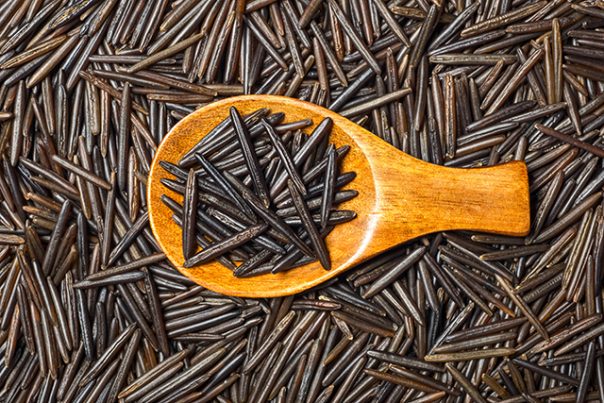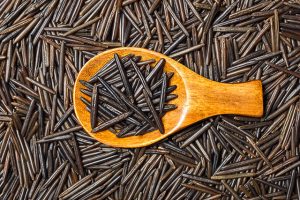
Wild Rice – sources, health benefits, nutrients, uses and constituents at NaturalPedia.com
Thursday, August 24, 2017 by Jhoanna Robinson
http://www.naturalpedia.com/wild-rice-sources-health-benefits-nutrients-uses-and-constituents-at-naturalpedia-com-2.html

Wild rice is a grass species that produce edible seeds that look like rice grains. It is more flavorful and is costlier than the common rice. It also contains more protein and other nutrients than the other grain crops. It is also high in carbohydrate content, but low in fat, a report from the University of Wisconsin Extension showed.
Wild rice has four different varieties. One of these is endemic to Asia and is used primarily as a vegetable. The other three are endemic to North America, particularly the Great Lakes region, and are used primarily as a grain.
Wild rice has a chewy outer sheath. It thrives in short stalks ensconced in shallow water, and are used by humans for various forms of consumption, and by aquatic animals.
Wild rice, which also takes the name of Indian rice, is widely utilized by native Americans, and takes center stage in some of their most important rituals.

List of known nutrients
- Copper
- Dietary Fiber
- Iron
- Lysine
- Magnesium
- Manganese
- Phosphorus
- Potassium
- Protein
- Selenium
- Vitamin B1 (Thiamine)
- Vitamin B2 (Riboflavin)
- Vitamin B3 (Niacin)
- Vitamin B6 (Pyridoxine)
- Vitamin B9 (Folate)
- Vitamin C
- Zinc
Medicinal uses for wild rice
Eating whole grains, especially wild rice, can prevent the onset of type-2 diabetes and regulate blood sugar levels.
Wild rice is good for weight-watchers. Unlike white rice, which actually makes you fat, wild rice prevents you from overeating because its high fiber content can make you feel full, leaving you with the feeling that there is no need to ingest large amounts of food during your next meal.
Body systems supported by wild rice
Wild rice is good for the cardiovascular system. In a general sense, the consumption of whole grains contribute to heart health by lessening the risks of related diseases. But you are taking it to the next level by eating wild rice. Since there is no sodium in wild rice, it helps regulate blood pressure.
Its high fiber content also makes it possible for the body to get rid of low-density lipoprotein (LDL) or bad cholesterol and thus lessens the risks of developing atherosclerosis. Finally, its vitamin C content helps lessen the strain on the heart by increasing its capability to repair and control the damage to cells.
Wild rice is good for the digestive system. The fiber in the grain bulks up your stool, thus contributing to a more optimized digestive process by preventing instances of constipation, bloating, cramping, diarrhea, and excess flatulence, as well as more grave gastrointestinal issues such as colorectal cancer, gastric ulcers, and hemorrhoids.
Wild rice is good for the skeletal system. It contributes to bone mineral density. With phosphorus and zinc included in its list of nutrients, you can be assured that your bones and joints grow strong as you age. It even lessens the symptoms who already have a tendency to have bone aches or those who are already afflicted with osteoporosis.
Wild rice is good for the ocular system. It prevents the onset of age-related eye disorders such as cataracts and macular degeneration.
Wild rice is good for the immune system. It contains powerful antioxidants that contribute to the general wellness of the body by neutralizing harmful free radicals that corrupt otherwise healthy cells in the body. These antioxidants also delay the onset of premature aging and its signs, such as wrinkles, age spots, blemishes, and fine lines, for a younger and more radiant you.
Wild rice is good for the muscular system. Its high protein content is essential in increasing muscle mass, ensuring proper growth, and providing for balanced development in our bodies.
Ways to use wild rice
Wild rice can be great alternatives to potatoes, pasta, or rice and can be added to give crunch to soups, casseroles, desserts, and salads.
Sometimes, however, wild rice may be contaminated with ergot or other kinds of heavy metals. Ergot, a type of fungus that usually infects grains, can cause side effects that include vomiting, diarrhea, headaches, mental impairment, nausea, and seizures. Toxic heavy metals such as arsenic, cadmium, and lead, on the other hand, can get stored in the body and cause serious ailments later in life like cancer.
Where to learn more
- 10 Easy Ways to Boost Your Immune System
- Flatulence-free belly: Six foods for a happy belly
- Aid Recovery from Alcohol Abuse with a Nourishing Diet
- Raw Foods That Increase Athletic Performance, by Triathlete Brendan Brazier
- What you need and need to know
Summary
Wild rice is good for the cardiovascular, digestive, skeletal, ocular, immune, and muscular systems.
Eating whole grains, especially wild rice, can prevent the onset of type-2 diabetes and regulate blood sugar levels.
Wild rice is good for weight-watchers.
Sources include:
Tagged Under: Tags: wild rice





